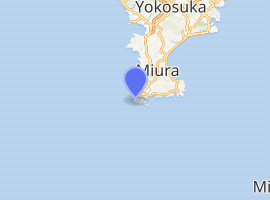Jōgashima Lighthouse
Jōgashima Lighthouse (城ヶ島灯台, Jōgashima tōdai) is a lighthouse located on the island of Jōgashima (Japanese: 城ヶ島) in the city of Miura, Kanagawa Prefecture, Japan, off the southernmost and western tip of Miura Peninsula, facing Sagami Bay. It is the fourth oldest western style lighthouse to be built in Japan, and the second oldest surviving to the present day.
Jōgashima Lighthouse | |
 | |

| |
| Location | Miura Kanagawa Prefecture Japan |
|---|---|
| Coordinates | 35°08′06.4″N 139°36′40.1″E |
| Year first constructed | 1870 (first) |
| Year first lit | 1925 (current) |
| Automated | yes |
| Foundation | concrete base |
| Construction | concrete tower |
| Tower shape | cylindrical tower with balcony and lantern |
| Markings / pattern | white tower and lantern |
| Tower height | 11.5 metres (38 ft) |
| Focal height | 30.1 metres (99 ft) |
| Original lens | 4th order Fresnel |
| Intensity | 400,000 candela |
| Range | 16 nautical miles (30 km; 18 mi)[1] |
| Characteristic | Fl W 15s |
| Admiralty number | M6343 |
| NGA number | 5368 |
| ARLHS number | JPN-203 |
| Japan number | JCG-2407[2] |
History
The Jōgashima Lighthouse was one of eight lighthouses built in Japan under the provisions of the Anglo-Japanese Treaty of Amity and Commerce of 1858, signed by the Bakumatsu period Tokugawa Shogunate. The lighthouse was designed and constructed by expatriate French engineer Léonce Verny. Verny constructed another three lighthouses around Tokyo Bay, and was also the engineer who built the nearby Yokosuka Naval Arsenal during his career in Japan.

The Jōgashima Lighthouse was completed on September 8, 1870 after the Meiji Restoration, and was originally built of brick. The original structure was destroyed during the Great Kantō earthquake on September 1, 1923 and was replaced with the current reinforced-concrete round structure on August 1, 1925. In 1928, its light source was changed from acetylene to electric, greatly increasing its visibility. The lighthouse has been unmanned since 1991. It is currently maintained by the Japan Coast Guard.
References
- Pedlar, Neil. The Imported Pioneers: Westerners who Helped Build Modern Japan. Routledge, 1990. ISBN 0-904404-51-X
